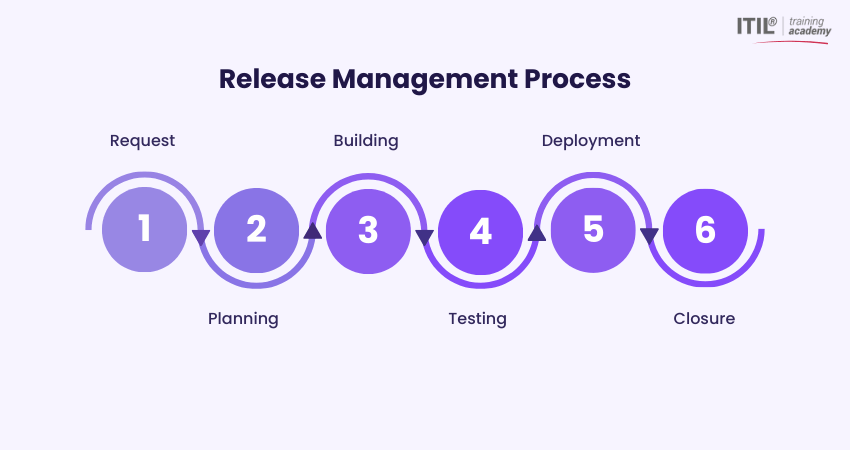
Author-Grace Mitchell
Last updated-Sep 20, 2025
Everyone looks forward to software updates, but no one wants the chaos that can come with them, such as system crashes, delays, or unhappy users. Without the right process, releases can become costly mistakes. Information Technology Infrastructure Library (ITIL) Release Management helps prevent this by making sure updates are delivered in a safe, planned, and reliable way.
In this blog, we’ll cover what is ITIL Release Management, how the process works step by step, and the key indicators that show it’s done right. We’ll also discuss the roles involved, the benefits it brings, and the best practices that help teams deliver updates with confidence.
Table of Contents
1) What is ITIL Release Management?
2) The Release Management Process
3) Key Indicators of Successful Release Management
4) ITIL Roles in Release Management
5) Benefits of ITIL Release Management
6) ITIL Release Management Best Practices
7) Conclusion
What is ITIL Release Management?
ITIL Release Management is a structured process of planning, building, testing, and delivering new or updated IT services into the live environment. The main goal is to keep systems stable, reliable, and secure while reducing disruptions to business operations.
This process controls every stage of a release. It reduces risks and improves service quality. It also helps organisations stay in line with business needs and industry standards. A release could be a software update, a new feature, or even a complete system upgrade. ITIL Release Management makes sure these changes happen in a safe and structured way.
The Release Management Process
The Release Management process is a step-by-step system that ensures new or updated IT services are delivered smoothly and with minimal risk. Each stage has a clear purpose and helps keep the production environment stable while meeting business goals. These are the process steps:

1) Request
Every release begins with a request, which may arise from business needs, customer feedback, or technical updates. The request is reviewed to determine whether it should proceed and is logged into the system for easy tracking. Clear communication at this stage helps prevent confusion later in the release cycle.
2) Planning
In this stage, the scope, timeline, and goals of the release are defined. Teams identify risks, assign responsibilities, and make sure the release aligns with business objectives. A detailed plan is created to guide all activities. Resources such as people, time, and tools are also arranged.
3) Building
The approved release is developed in this phase. Developers prepare the necessary code, configurations, or other components. Supporting documentation and deployment instructions are also produced. The team ensures the build meets the agreed requirements, using version control to track changes.
4) Testing
Testing verifies that the release is stable, secure, and meets defined requirements. Functional, regression, and security testing may be performed. Any defects are resolved before deployment. This stage helps reduce the risk of issues reaching end-users and ensures quality assurance.
5) Deployment
The release is moved into the live environment. This may be done in phases, starting with a small group of users, to reduce disruption and ensure success. Deployment can be automated to make it faster and safer. Backup and rollback plans are also in place in case something goes wrong.
6) Closure
Once deployment is complete, the release is formally closed. Feedback is collected, performance is monitored, and lessons are recorded to improve future releases. A closure report has been prepared to document the results. Teams celebrate success and note areas of improvement.
Master risk control and compliance. Join our ITIL® 4 Practitioner Information Security Management Training now.
Key Indicators of Successful Release Management
A release is considered successful if it meets certain indicators. These are the key indicators of Successful Release Management:
1) Timely Deployments
A good release is delivered on time. Meeting deadlines shows that the process was planned and carried out well. Timely updates also reduce delays and give users access to new features when expected. This builds trust with clients and shows that the team can manage projects effectively.
2) User Satisfaction
Happy users are a clear sign of success. If updates meet their needs and work smoothly, they will share positive feedback. Surveys, reviews, or direct feedback can help measure user satisfaction. High satisfaction also leads to stronger loyalty and long-term customer retention.
3) High-quality Releases
Releases must meet defined requirements and operate without major issues. Thorough testing and quality checks before deployment help ensure this. High-quality releases result in fewer errors and a better user experience, while also reducing the cost of post-launch fixes.
4) Minimal Disruption and Downtime
Successful releases are designed to cause little to no interruption. Careful planning and testing allow systems to remain operational during updates. This ensures that users can continue working without disruption, leading to higher productivity and improved customer confidence.
5) Compliance with Rules and Standards
Releases should follow company policies, laws, and industry standards. This reduces risks linked to security, privacy, and quality. Following the rules also avoids legal or financial problems. It also shows that the organisation takes safety and accountability seriously.
6) Alignment with Business Objectives
Every release should support business goals. This could mean improving efficiency, helping growth, or boosting customer trust. When releases match company objectives, they add real value. It ensures that IT efforts directly support the organisation’s wider vision.
7) Efficient Resource Utilisation
Resources like time, money, and people must be used wisely. A well-planned release avoids waste and stays within budget. This makes the process smooth and cost-effective. It also improves team performance by avoiding overwork or underuse of skills.
8) Continuous Improvement
Successful Release Management does not stop at delivery. Teams review performance, collect feedback, and look for ways to improve. Each release makes the next one better and more efficient. This culture of improvement helps organisations stay competitive and adaptive.
Strengthen governance and reliability with our ITIL® 4 Specialist: Plan, Implement and Control Training – Join now!
ITIL Roles in Release Management
Release Management needs many people to work together. Each role has its own job, and all of them help make the release safe and successful.
1) Release Manager: This person leads the whole release. They plan, organise, and make sure the release happens on time. They also fix problems if something goes wrong.
2) Change Manager: They check and approve changes before they are added to the release. Their job is to make sure changes are safe and follow rules.
3) Test Manager: This person makes sure the testing is done properly. They check the release for errors and confirm that it works as expected.
4) Deployment Manager: They take care of putting the release into the live system. They plan the rollout, so users are not disturbed.
5) Developers and Engineers: They build the release. Developers write code and fix issues, while engineers prepare the setup and system parts.
6) Service Desk: After the release, this team helps users. They answer questions, solve issues, and collect feedback to improve future releases.
All these roles work together like pieces of a puzzle. Each one is important, and together they make sure nothing is missed.
Benefits of ITIL Release Management
ITIL Release Management brings many advantages to organisations. It makes releases safer, faster, and more reliable.

1) Better Quality of Service: Because every release is planned and tested, there are fewer mistakes. This means users get stable and reliable services.
2) Reduced Risk: Following a step-by-step process lowers the chance of errors or failures. It keeps the living environment safe.
3) Faster Delivery: With clear planning and roles, updates can be delivered more quickly. This helps businesses stay ahead of changes and demands.
4) Improved Customer Satisfaction: Users face fewer problems and get smoother services. Happy users are more likely to trust and stay with the organisation.
5) Cost Efficiency: Resources like time, money, and staff are used wisely. Less waste means lower costs and better value for the business.
6) Compliance: The process ensures updates follow laws, company policies, and industry standards. This avoids legal issues and builds trust.
7) Knowledge Sharing: Each release is well-documented. Teams can learn from past work and use it to improve future releases.
8) Flexibility: ITIL works well even in complex IT environments. It allows updates to be rolled out smoothly without major disruptions.
All these benefits mean IT teams work more effectively, while businesses meet goals and deliver value to customers.
Reduce deployment risk and streamline releases with our ITIL® 4 Practitioner: Deployment Management Training - Register today!
ITIL Release Management Best Practices
To get the best results from Release Management, organisations should follow proven best practices. These make the process smoother, safer, and more reliable.
1) Remain Fluid
Stay flexible, as IT environments evolve quickly. New requirements or issues may arise during a release, and the process should adapt without causing delays. Being agile ensures the release stays on track and meets changing demands effectively.
2) Minimise User Impact
Plan updates in a way that minimises disruption to users. For example, carry out deployments at night or during low-usage hours. This way, people can continue working without problems. Fewer disruptions mean higher satisfaction.
3) Leverage Automation
Automation tools save time and reduce mistakes. They can handle tasks like testing, building, or deployment faster than manual work. Automation also ensures the process is repeatable and consistent every time.
4) Integrate Security Early
Security should be embedded from the beginning of the release process, not left until the end. Conduct security checks at each stage to prevent vulnerabilities, protect sensitive data, and avoid costly fixes later. Early integration of security also helps build user trust in the system.
5) Strengthen Access Control
Only authorised people should be able to make changes. This prevents errors and reduces the risks of security breaches. Strong access rules also keep systems safe from misuse. It also ensures clear accountability for every change made.
6) Ensure Full Visibility
Everyone involved should know what is happening. Regular updates and clear reports keep teams and stakeholders informed. Transparency builds trust, avoids confusion, and helps solve issues faster.
Conclusion
ITIL Release Management gives organisations a clear way to plan, test, and deliver updates without disrupting business. By following structured steps and best practices, teams reduce risks, save costs, and keep users satisfied. Strong indicators like quality, compliance, and efficiency show success. With strong Release Management, businesses deliver reliable services and reach their long-term goals through Release Management in ITIL.
Secure cross-practice excellence. Start your ITIL® 4 Practice Manager (PM) Training today!
Most Recent
Date - Sep 20, 2025
Date - Sep 20, 2025
Date - Sep 20, 2025





 Back to
Topics
Back to
Topics

























